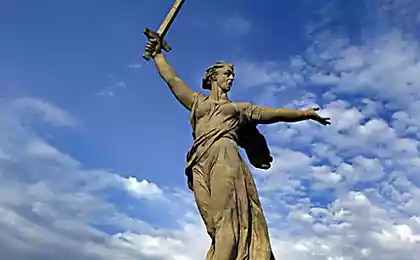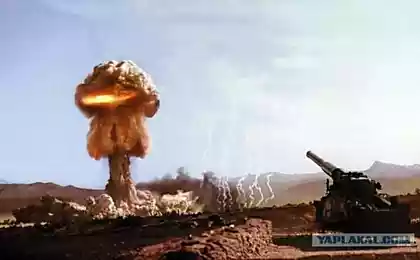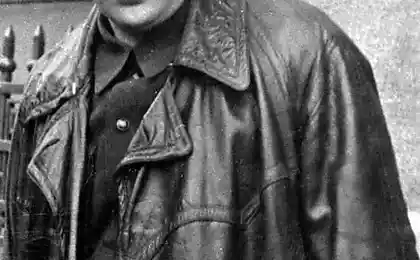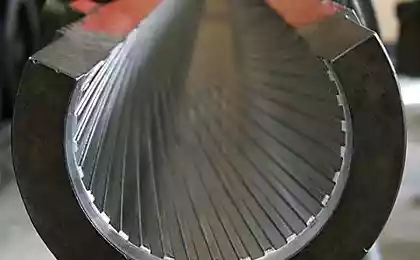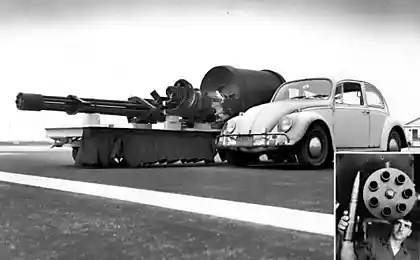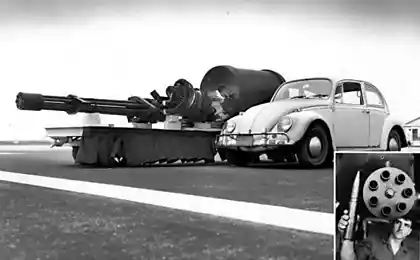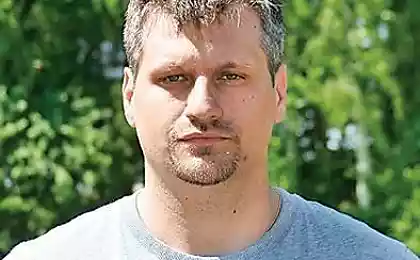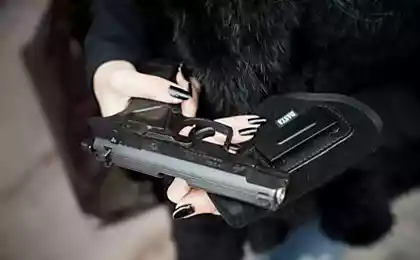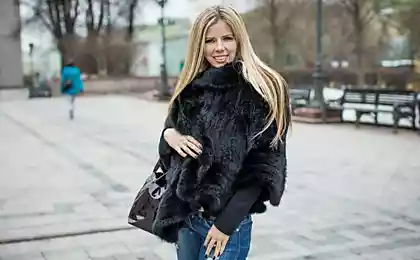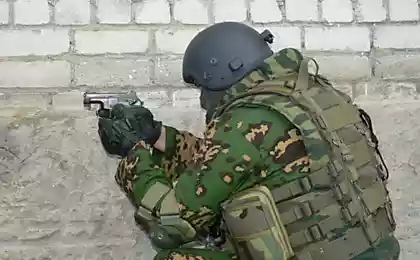1848
History Tsar Cannon
As is known Tsar Cannon - a medieval artillery guns and a monument of Russian artillery, cast in bronze in 1586 by Russian master Andrei Chokhov at the Cannon yard. Today we will try to find out whether it is possible to shoot out of it and it's still a sham.
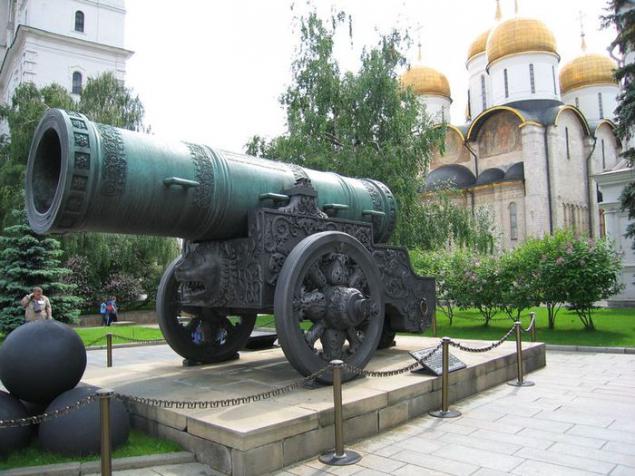
The author writes: The people walk a lot of misconceptions about it. For example: "In Russia, was the most powerful and advanced in the world industrial and technological base of the manufacture of cast iron, the monuments which are also these unique artifacts (it's about Tsar Bell and Tsar Cannon, - Ed.) ... Has long been proven, and there is documentary evidence that the Tsar Cannon actually shot ».
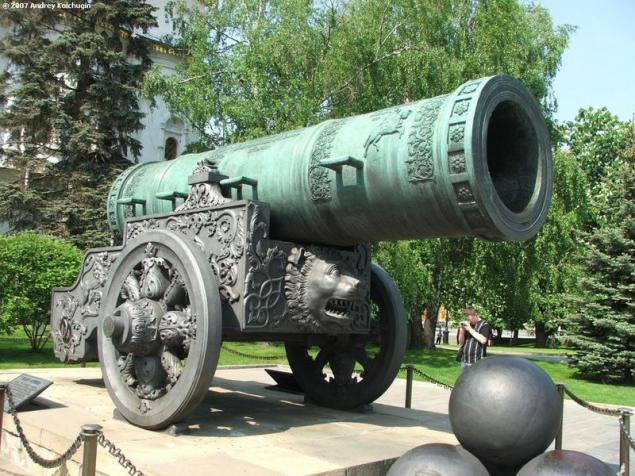
As the bell is clear. They are made entirely of bronze, and not all, and a special composition. Well, the gun, of course, are different. To do this in difficult times, our wonderful people even used birch burl. We took a dense birch blank dumpy, made a hole in it, okovyvali iron bars, burning through a small hole in the breech of a cannon fuse and now is ready. In the 17th and 19th centuries ... them, mainly iron already poured. But Tsar Cannon still bronze.
On the documentary evidence that the gun is fired, an important remark. Indeed, the people spinning information that some experts to ascertain ... discovered ... etc. This rumor started by journalists. About who and what really set it will be explained in detail below. Also consider another error, which roams in the minds of scientists. Many of them believe that the Tsar Cannon, is a huge shotgun. Very convenient opinion which allows historians to explain many mysteries associated with it. In fact, this is not so, which will be clearly shown.
There is one more stable and error, casts doubt on the wisdom of human nature. It is said that Tsar Cannon made to frighten foreigners, especially after the Crimean Tatars. The absurdity of this statement, too, will become apparent upon reading the article.
What you can bring arguments:
Firstly, the striking iron core, which in the 19th century and became a source of ever talk about guns decorative purposes. In the 16th century used the stone balls, and they are 2, 5 times lighter than the exposed cast iron. You can definitely say that the walls of the gun would not stand the pressure of powder gases when firing such a kernel. Of course, it is understood, when they were cast in the factory Byrd.
Secondly, sham flitches molded therein. Shoot him impossible. When fired, tenured stone 800 pound nucleus of the 40-ton Tsar Cannon, even with a small initial velocity of 100 meters per second, the following will occur:
expanding powder gases, creating increased pressure, as it would push the space between the core and the bottom of the gun; the kernel will start moving in one direction, and a gun - in the opposite, with the speed of their movement will be inversely proportional to the mass (how many times lighter body, as many times faster than the fly).
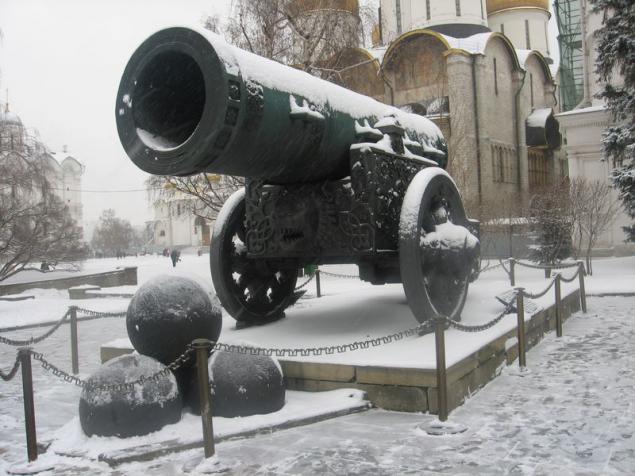
Weight gun only 50 times the mass of the nucleus (in the Kalashnikovs, for example, the ratio of 400), so that the kernel will fly forward at a speed of 100 meters per second, the gun back roll at a speed of about 2 meters per second. This machine will stop at once, still 40 tonnes. Energy rollback will be approximately equal to the hard beat of KAMAZ an obstacle at a speed of 30 km / h. Tsar Cannon frustrate a carriage. Moreover, it is just lying on it from above, like a log. To keep all of this can only be a special sliding carriage with hydraulic dampers (absorbers rollback), and reliable fastening tools. I assure you, it is today a pretty impressive device, and while this was not simple. And all this is not just my opinion: "At present the Tsar Cannon is on the cast iron decorative carriage and lie next to decorative cast-iron core, which was cast in 1834 in St. Petersburg at the Ironworks Byrd. It is clear that neither the shoot with this iron mast or use the iron core is physically impossible - Tsar Cannon will spread to smithereens! "(Alexander Shirokorad" miracle weapon of the Russian Empire "). Therefore, the artillery system, which we show in the Kremlin called the Tsar Cannon, a giant props.
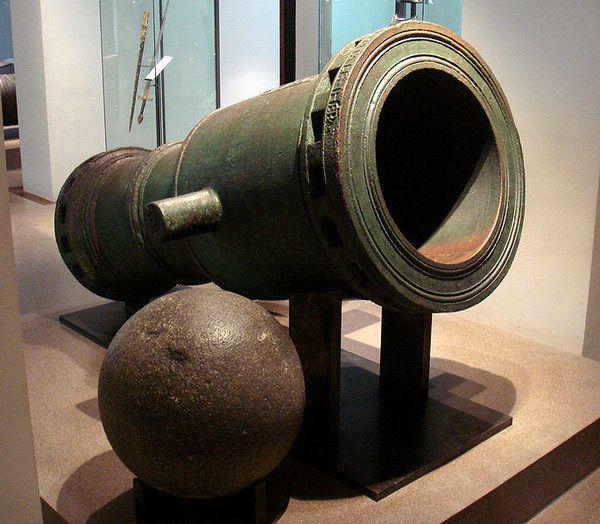
Today, persistently exaggerated hypothesis on the application of the Tsar Cannon as a shotgun. Opinion is very convenient for historians. If this shotgun, it will not have to carry. I put a loophole, and all wait for the enemy.

Today, persistently exaggerated hypothesis on the application of the Tsar Cannon as a shotgun. Opinion is very convenient for historians. If this shotgun, it will not have to carry. I put a loophole, and all wait for the enemy.
That cast Chokhov Andrew in 1586, that is, himself the bronze barrel could really shoot. Just look to it is not so, as many people think. The fact that its design Tsar Cannon is not a gun, and the classical bombard. Cannon called gun with a barrel length of 40 calibers and up. At the Tsar Cannon barrel length of 4 caliber. And to bombard it just fine. They often have an impressive size, and were used for the siege as a battering ram. In order to destroy the fortress wall, you need a very hard shell. For this and giant sizes.
Neither of which carriage it was not then. Barrel simply dripped into the ground. The flat end rests on the deep pocketed piles (Fig. 2). Nearby 2 more digging trench for artillery calculation because such instruments are often broken. The loading sometimes take hours. Hence the rate of such weapons - from 1 to 6 rounds per day. But it was worth it, since it allows to crush impregnable walls, to do without many months of siege and reduce combat casualties in the assault.
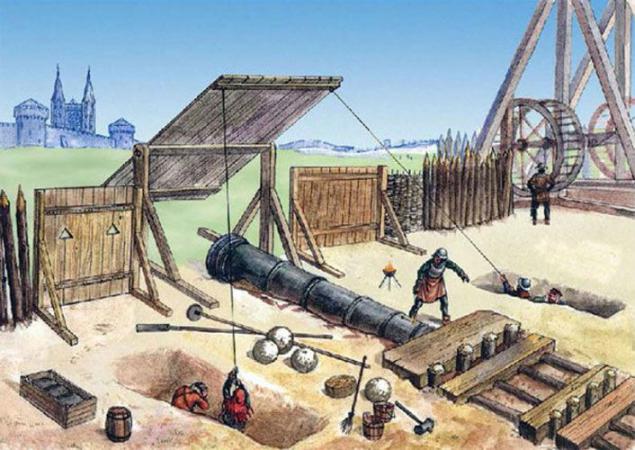
Only in this sense can be cast 40-ton barrel caliber of 900 mm. Tsar Cannon is bombard - battering ram intended to besiege enemy castles, not a shotgun, as some tend to believe.
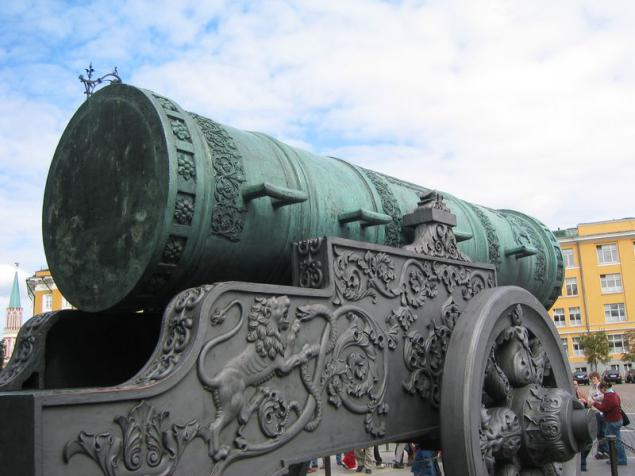
That's the opinion of the expert on the subject: "... as the shotgun Tsar Cannon was extremely inefficient. At cost, instead it could make 20 small shotguns for loading not to be a day and only 1-2 minutes. Note that in the official inventory of "In Moscow arsenal consisting of artillery" in the 1730 top 40 copper and iron 15 shotguns. Pay attention to their caliber: £ 1,500 - 1 (this is the Tsar Cannon), and then followed gauges: £ 25 - 2, 22 pounds - 1, 21 pounds - 3, etc. The largest number of shotguns, 11, falls on the 2-pound caliber. Rhetorical question: what place thought our military recorded Tsar Cannon in shotguns? .. "(Alexander Shirokorad" miracle weapon of the Russian Empire ").

Tsar Cannon has never been used for its intended purpose

As mentioned earlier in this article, there are rumors about some "Documentary evidence" that the Tsar Cannon shot. In fact, it is of great importance not only to the fact of the shot, but also what she shot, and under what circumstances. Cores, which charges the cannon could have different weights, and weighed the powder could be different. It depends on this pressure in the bore and the power shot. All this is not to define. In addition, if the tools were made from the trial test shots, then this one, and if it was used in combat - is quite another. Here is a quote about this:
"Documents on the tests of the Tsar Cannon and applying it in combat conditions are not kept, that was the basis for later historians for long dispute about her appointment ... A minority of experts generally excludes the possibility of combat use of the gun, and made it to frighten foreigners, especially after the Crimean Tatars ... An interesting detail, in 1980, studied the instrument channel of experts Academy. Dzerzhinsky concluded that of the Tsar Cannon shot at least one time ... "(Alexander Shirokorad" miracle weapon of the Russian Empire ").
By the way, most of these experts report for unknown reasons was never published. And if the report does not show to anybody, it is not proof. The phrase "shot at least one time" apparently someone of them was dropped in a conversation or an interview, and then we would do nothing about it know. If the gun is used as intended, it is inevitable in the trunk would have not only the particles of powder, which is rumored to have been discovered and, and mechanical damage in the form of longitudinal scratches. In the battle of the Tsar Cannon shot would not have wool and stone balls weighing about 800 kg.

There must be some wear surface of the barrel. It could not be, because the bronze rather soft material. The expression "at least" just shows that in addition to the particles of powder there is nothing substantial could not be found. If so, the gun is not used for its intended purpose. A powder particles may remain on the test shots. The point in this issue puts the fact that the Tsar Cannon has never left outside Moscow:
"After the Tsar Cannon was cast and finished at the Cannon yard, he dragged her to the bridge Spassky and laid on the ground next to a gun," Peacock ". To move the cannon to the eight rungs on its barrel tied ropes to the rope at the same time 200 horses harnessed, and they rolled the gun lying on the huge logs-rinks. Originally cannon "King" and "Peacock" lying on the ground near the bridge leading to the Spassky Tower and Kashpirova gun - from the Land of the order, which was located in what is now the Historical Museum. In 1626 they rose from the ground and set on log house, tightly packed earth. These platforms called roskaty ... "(Alexander Shirokorad" miracle weapon of the Russian Empire ").
At home, used a battering ram to destination somehow suicidal. As someone about to shoot 800 pound nucleus from the walls of the Kremlin? On manpower enemy 1 per day to shoot pointless. Tanks did not exist. Perhaps we are expecting the appearance of Godzilla. Of course, these huge rams were put on public display is not martial purposes, as an element of prestige and power. And, of course, it was not their main purpose. Under Peter I Tsar Cannon established in the territory of the Kremlin itself. There it remains to this day. Why is it never used in combat, though as a battering ram quite battle-worthy? Maybe the reason for that is its too great weight? Is it possible to be moved is a tool for long distances?
Transportation
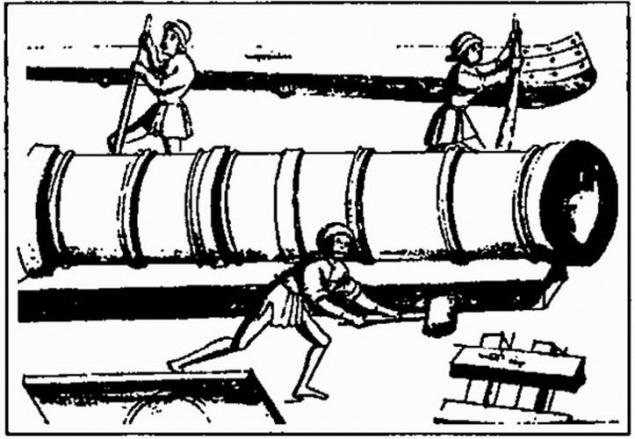
Modern historians seldom ask themselves the question: "Why?". And the question - extremely helpful. So let us ask, what was cast siege weapon weighing 40 tons, if it can not be delivered to the enemy city? In order to scare the ambassadors? Hardly. Could this make for a cheap layout, and show it from afar. Why so much work and bronze spend on a bluff? No, the Tsar Cannon was cast to use it practically. So could and move. How could they do this?
40 tons - it is really very hard. This weight is not able to translate the Kamaz truck. It is designed only for 10 tons of cargo. When you try to load a gun at him, first destroyed the suspension, then pognёtsya frame. For this you need a tractor to 4 times more durable and powerful. And all that could be made of wood, with the purpose of convenient transportation cannon on wheels, would truly cyclopean proportions. The axis of the wheeled device would be a minimum thickness of 80 cm. Then it makes no sense to imagine still no evidence of something like this. Everywhere it is written that the Tsar Cannon was dragged rather than carried.
See figure, where heavy loaded gun. Unfortunately, here we see only pushing bombard the present, not the process of moving. But in the background is visible transport platform. She bent to the top of the nose of the (anti-utykaniya in irregularities). Platform is clearly used to slip. That is, the load dragged, not rolled. And it is right. Rollers can be used only on a flat, hard surface. Where this will find? It is quite clear, and that the bent nose portion bound with metal, because the load is very heavy. Weight majority battering rams did not exceed 20 tons.
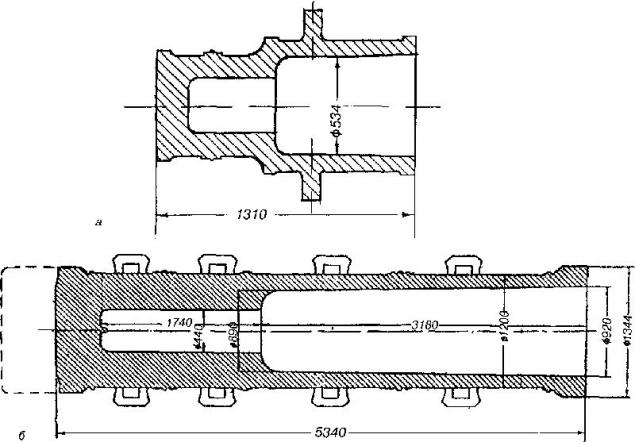
Assume that the main part of the way they overcame the water. Moving these bombards dragged a short distance of several kilometers by a variety of horses, also doable task, but not an easy and very. But can we do the same with a 40 ton instrument? Typically, these studies end with expressions such as "historical incident." Like nedotёpy decided to surprise everyone, cast something to record giant, but as a drag not think. That, they say, as it is in Russian - Tsar Bell, which does not ring and the Tsar Cannon, who does not shoot.
But we do not continue in this spirit. Let's say goodbye to the idea that our leaders were foolish historians today. Rather blame everything on the inexperience of masters and tyranny of kings. The king, who managed to occupy this high office, ordered the 40 ton cannon pay his production, was clearly no fool, and was very good to think about his actions. These costly issues with kondachka not solved. He knew exactly how this is going to deliver a "gift" to the walls of enemy cities.
The great weapon of Malik-e-Maidan
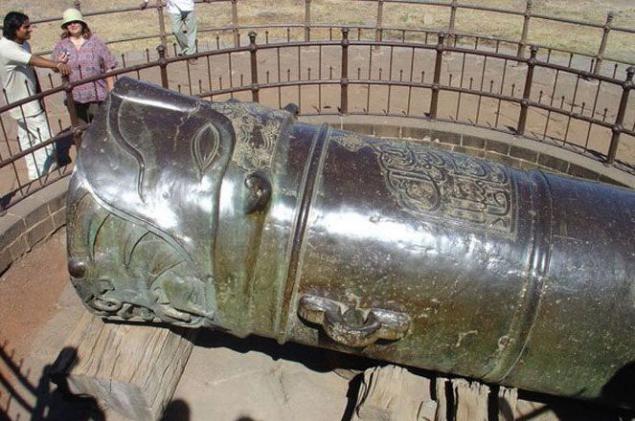
By the way, an excuse like "first made, and then to think about how drag" is quite common in historical research. It has become customary. Not so long ago the channel told the audience about the culture of traditional Chinese architecture. Revealed Carved into the rock slab weighing 86,000 tons. The explanation in general is: "The Chinese emperor supposedly had mental health problems on the basis of a giant vanity and ordered a tomb unimaginable dimensions. He, architects, thousands of masons were allegedly mentally disabled and in terms of logic. For decades, they conducted a mega-project. We cut down, finally, the plate and only then realized that even with the place will not be able to move it. Well, give it up ... "It looks like our case.
That Tsar Cannon - is not just a surge of interest in Moscow casters, proving the existence of even more huge guns Malik-e-Maidan. It was cast in-Ahman Dagar in India in 1548, and has a whole lot of 57 tonnes. There's historians also sing songs about elephants and 10 400 buffaloes, taschivshih this gun. It is also intended siege weapon, as the Tsar Cannon, only 17 tons heavier. What is the second historical incident in the same historical time? And how many more of these tools need to discover in order to understand that while they were cast, was delivered to the besieged city and practically used? If we do not understand how this happened, then, it is our knowledge.
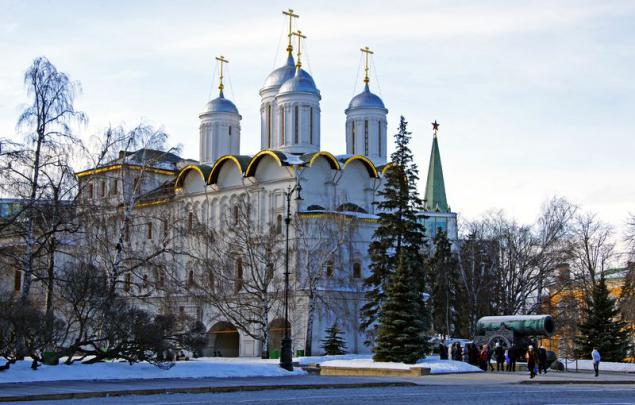
That Tsar Cannon - is not just a surge of interest in Moscow casters, proving the existence of even more huge guns Malik-e-Maidan. It was cast in-Ahman Dagar in India in 1548, and has a whole lot of 57 tonnes. There's historians also sing songs about elephants and 10 400 buffaloes, taschivshih this gun. It is also intended siege weapon, as the Tsar Cannon, only 17 tons heavier. What is the second historical incident in the same historical time? And how many more of these tools need to discover in order to understand that while they were cast, was delivered to the besieged city and practically used? If we do not understand how this happened, then this is our knowledge.
Here again we are faced with a net-low of today's technological culture. This is due to distorted scientific worldview. With modern point we do not see the solution, which was evident at the time. It remains to conclude that even in the 16th century in Russia and in India, knew something that allows you to move these loads.
Decline artillery technology in the Middle Ages
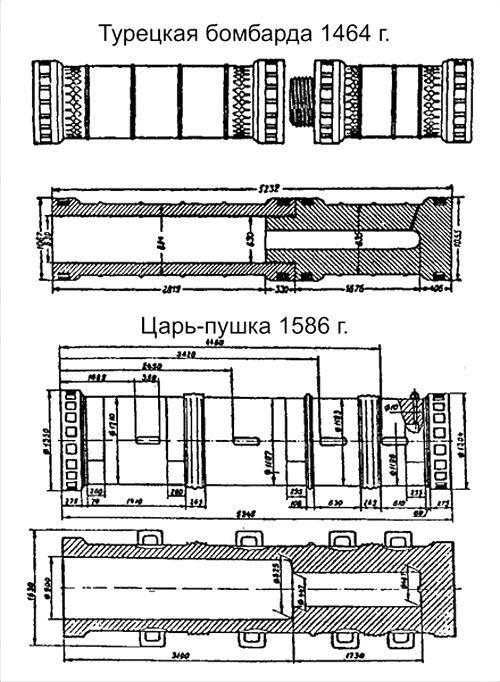
For example bombards you can see the obvious degradation of the artillery of art over the centuries of the Middle Ages. The first samples were made of double-layer iron. The inner layer was welded of the longitudinal strips and outside its fortified thick transverse rings. After some time, began to make tools out of bronze alloy. This clearly reduced their reliability, and therefore, increase the weight. Any engineer will confirm that the wrought iron on the order of stronger cast bronze. Especially if it is collected as described above - a two-layer package with the direction of fibers corresponding load. Probably, the reason is an effort to reduce the cost of the manufacturing process.
The construction of the first bombards too surprisingly progressive. For example, today you will not find modern samples of small arms, which are charged to the muzzle side of the hole. It is very primitive. One and a half century in the course of loading to breech. In this way many advantages - and the rate is higher and more convenient service tools.
Source: masterok.livejournal.com

The author writes: The people walk a lot of misconceptions about it. For example: "In Russia, was the most powerful and advanced in the world industrial and technological base of the manufacture of cast iron, the monuments which are also these unique artifacts (it's about Tsar Bell and Tsar Cannon, - Ed.) ... Has long been proven, and there is documentary evidence that the Tsar Cannon actually shot ».

As the bell is clear. They are made entirely of bronze, and not all, and a special composition. Well, the gun, of course, are different. To do this in difficult times, our wonderful people even used birch burl. We took a dense birch blank dumpy, made a hole in it, okovyvali iron bars, burning through a small hole in the breech of a cannon fuse and now is ready. In the 17th and 19th centuries ... them, mainly iron already poured. But Tsar Cannon still bronze.
On the documentary evidence that the gun is fired, an important remark. Indeed, the people spinning information that some experts to ascertain ... discovered ... etc. This rumor started by journalists. About who and what really set it will be explained in detail below. Also consider another error, which roams in the minds of scientists. Many of them believe that the Tsar Cannon, is a huge shotgun. Very convenient opinion which allows historians to explain many mysteries associated with it. In fact, this is not so, which will be clearly shown.
There is one more stable and error, casts doubt on the wisdom of human nature. It is said that Tsar Cannon made to frighten foreigners, especially after the Crimean Tatars. The absurdity of this statement, too, will become apparent upon reading the article.
What you can bring arguments:
Firstly, the striking iron core, which in the 19th century and became a source of ever talk about guns decorative purposes. In the 16th century used the stone balls, and they are 2, 5 times lighter than the exposed cast iron. You can definitely say that the walls of the gun would not stand the pressure of powder gases when firing such a kernel. Of course, it is understood, when they were cast in the factory Byrd.
Secondly, sham flitches molded therein. Shoot him impossible. When fired, tenured stone 800 pound nucleus of the 40-ton Tsar Cannon, even with a small initial velocity of 100 meters per second, the following will occur:
expanding powder gases, creating increased pressure, as it would push the space between the core and the bottom of the gun; the kernel will start moving in one direction, and a gun - in the opposite, with the speed of their movement will be inversely proportional to the mass (how many times lighter body, as many times faster than the fly).

Weight gun only 50 times the mass of the nucleus (in the Kalashnikovs, for example, the ratio of 400), so that the kernel will fly forward at a speed of 100 meters per second, the gun back roll at a speed of about 2 meters per second. This machine will stop at once, still 40 tonnes. Energy rollback will be approximately equal to the hard beat of KAMAZ an obstacle at a speed of 30 km / h. Tsar Cannon frustrate a carriage. Moreover, it is just lying on it from above, like a log. To keep all of this can only be a special sliding carriage with hydraulic dampers (absorbers rollback), and reliable fastening tools. I assure you, it is today a pretty impressive device, and while this was not simple. And all this is not just my opinion: "At present the Tsar Cannon is on the cast iron decorative carriage and lie next to decorative cast-iron core, which was cast in 1834 in St. Petersburg at the Ironworks Byrd. It is clear that neither the shoot with this iron mast or use the iron core is physically impossible - Tsar Cannon will spread to smithereens! "(Alexander Shirokorad" miracle weapon of the Russian Empire "). Therefore, the artillery system, which we show in the Kremlin called the Tsar Cannon, a giant props.

Today, persistently exaggerated hypothesis on the application of the Tsar Cannon as a shotgun. Opinion is very convenient for historians. If this shotgun, it will not have to carry. I put a loophole, and all wait for the enemy.

Today, persistently exaggerated hypothesis on the application of the Tsar Cannon as a shotgun. Opinion is very convenient for historians. If this shotgun, it will not have to carry. I put a loophole, and all wait for the enemy.
That cast Chokhov Andrew in 1586, that is, himself the bronze barrel could really shoot. Just look to it is not so, as many people think. The fact that its design Tsar Cannon is not a gun, and the classical bombard. Cannon called gun with a barrel length of 40 calibers and up. At the Tsar Cannon barrel length of 4 caliber. And to bombard it just fine. They often have an impressive size, and were used for the siege as a battering ram. In order to destroy the fortress wall, you need a very hard shell. For this and giant sizes.
Neither of which carriage it was not then. Barrel simply dripped into the ground. The flat end rests on the deep pocketed piles (Fig. 2). Nearby 2 more digging trench for artillery calculation because such instruments are often broken. The loading sometimes take hours. Hence the rate of such weapons - from 1 to 6 rounds per day. But it was worth it, since it allows to crush impregnable walls, to do without many months of siege and reduce combat casualties in the assault.

Only in this sense can be cast 40-ton barrel caliber of 900 mm. Tsar Cannon is bombard - battering ram intended to besiege enemy castles, not a shotgun, as some tend to believe.

That's the opinion of the expert on the subject: "... as the shotgun Tsar Cannon was extremely inefficient. At cost, instead it could make 20 small shotguns for loading not to be a day and only 1-2 minutes. Note that in the official inventory of "In Moscow arsenal consisting of artillery" in the 1730 top 40 copper and iron 15 shotguns. Pay attention to their caliber: £ 1,500 - 1 (this is the Tsar Cannon), and then followed gauges: £ 25 - 2, 22 pounds - 1, 21 pounds - 3, etc. The largest number of shotguns, 11, falls on the 2-pound caliber. Rhetorical question: what place thought our military recorded Tsar Cannon in shotguns? .. "(Alexander Shirokorad" miracle weapon of the Russian Empire ").

Tsar Cannon has never been used for its intended purpose

As mentioned earlier in this article, there are rumors about some "Documentary evidence" that the Tsar Cannon shot. In fact, it is of great importance not only to the fact of the shot, but also what she shot, and under what circumstances. Cores, which charges the cannon could have different weights, and weighed the powder could be different. It depends on this pressure in the bore and the power shot. All this is not to define. In addition, if the tools were made from the trial test shots, then this one, and if it was used in combat - is quite another. Here is a quote about this:
"Documents on the tests of the Tsar Cannon and applying it in combat conditions are not kept, that was the basis for later historians for long dispute about her appointment ... A minority of experts generally excludes the possibility of combat use of the gun, and made it to frighten foreigners, especially after the Crimean Tatars ... An interesting detail, in 1980, studied the instrument channel of experts Academy. Dzerzhinsky concluded that of the Tsar Cannon shot at least one time ... "(Alexander Shirokorad" miracle weapon of the Russian Empire ").
By the way, most of these experts report for unknown reasons was never published. And if the report does not show to anybody, it is not proof. The phrase "shot at least one time" apparently someone of them was dropped in a conversation or an interview, and then we would do nothing about it know. If the gun is used as intended, it is inevitable in the trunk would have not only the particles of powder, which is rumored to have been discovered and, and mechanical damage in the form of longitudinal scratches. In the battle of the Tsar Cannon shot would not have wool and stone balls weighing about 800 kg.

There must be some wear surface of the barrel. It could not be, because the bronze rather soft material. The expression "at least" just shows that in addition to the particles of powder there is nothing substantial could not be found. If so, the gun is not used for its intended purpose. A powder particles may remain on the test shots. The point in this issue puts the fact that the Tsar Cannon has never left outside Moscow:
"After the Tsar Cannon was cast and finished at the Cannon yard, he dragged her to the bridge Spassky and laid on the ground next to a gun," Peacock ". To move the cannon to the eight rungs on its barrel tied ropes to the rope at the same time 200 horses harnessed, and they rolled the gun lying on the huge logs-rinks. Originally cannon "King" and "Peacock" lying on the ground near the bridge leading to the Spassky Tower and Kashpirova gun - from the Land of the order, which was located in what is now the Historical Museum. In 1626 they rose from the ground and set on log house, tightly packed earth. These platforms called roskaty ... "(Alexander Shirokorad" miracle weapon of the Russian Empire ").
At home, used a battering ram to destination somehow suicidal. As someone about to shoot 800 pound nucleus from the walls of the Kremlin? On manpower enemy 1 per day to shoot pointless. Tanks did not exist. Perhaps we are expecting the appearance of Godzilla. Of course, these huge rams were put on public display is not martial purposes, as an element of prestige and power. And, of course, it was not their main purpose. Under Peter I Tsar Cannon established in the territory of the Kremlin itself. There it remains to this day. Why is it never used in combat, though as a battering ram quite battle-worthy? Maybe the reason for that is its too great weight? Is it possible to be moved is a tool for long distances?
Transportation

Modern historians seldom ask themselves the question: "Why?". And the question - extremely helpful. So let us ask, what was cast siege weapon weighing 40 tons, if it can not be delivered to the enemy city? In order to scare the ambassadors? Hardly. Could this make for a cheap layout, and show it from afar. Why so much work and bronze spend on a bluff? No, the Tsar Cannon was cast to use it practically. So could and move. How could they do this?
40 tons - it is really very hard. This weight is not able to translate the Kamaz truck. It is designed only for 10 tons of cargo. When you try to load a gun at him, first destroyed the suspension, then pognёtsya frame. For this you need a tractor to 4 times more durable and powerful. And all that could be made of wood, with the purpose of convenient transportation cannon on wheels, would truly cyclopean proportions. The axis of the wheeled device would be a minimum thickness of 80 cm. Then it makes no sense to imagine still no evidence of something like this. Everywhere it is written that the Tsar Cannon was dragged rather than carried.
See figure, where heavy loaded gun. Unfortunately, here we see only pushing bombard the present, not the process of moving. But in the background is visible transport platform. She bent to the top of the nose of the (anti-utykaniya in irregularities). Platform is clearly used to slip. That is, the load dragged, not rolled. And it is right. Rollers can be used only on a flat, hard surface. Where this will find? It is quite clear, and that the bent nose portion bound with metal, because the load is very heavy. Weight majority battering rams did not exceed 20 tons.

Assume that the main part of the way they overcame the water. Moving these bombards dragged a short distance of several kilometers by a variety of horses, also doable task, but not an easy and very. But can we do the same with a 40 ton instrument? Typically, these studies end with expressions such as "historical incident." Like nedotёpy decided to surprise everyone, cast something to record giant, but as a drag not think. That, they say, as it is in Russian - Tsar Bell, which does not ring and the Tsar Cannon, who does not shoot.
But we do not continue in this spirit. Let's say goodbye to the idea that our leaders were foolish historians today. Rather blame everything on the inexperience of masters and tyranny of kings. The king, who managed to occupy this high office, ordered the 40 ton cannon pay his production, was clearly no fool, and was very good to think about his actions. These costly issues with kondachka not solved. He knew exactly how this is going to deliver a "gift" to the walls of enemy cities.
The great weapon of Malik-e-Maidan

By the way, an excuse like "first made, and then to think about how drag" is quite common in historical research. It has become customary. Not so long ago the channel told the audience about the culture of traditional Chinese architecture. Revealed Carved into the rock slab weighing 86,000 tons. The explanation in general is: "The Chinese emperor supposedly had mental health problems on the basis of a giant vanity and ordered a tomb unimaginable dimensions. He, architects, thousands of masons were allegedly mentally disabled and in terms of logic. For decades, they conducted a mega-project. We cut down, finally, the plate and only then realized that even with the place will not be able to move it. Well, give it up ... "It looks like our case.
That Tsar Cannon - is not just a surge of interest in Moscow casters, proving the existence of even more huge guns Malik-e-Maidan. It was cast in-Ahman Dagar in India in 1548, and has a whole lot of 57 tonnes. There's historians also sing songs about elephants and 10 400 buffaloes, taschivshih this gun. It is also intended siege weapon, as the Tsar Cannon, only 17 tons heavier. What is the second historical incident in the same historical time? And how many more of these tools need to discover in order to understand that while they were cast, was delivered to the besieged city and practically used? If we do not understand how this happened, then, it is our knowledge.

That Tsar Cannon - is not just a surge of interest in Moscow casters, proving the existence of even more huge guns Malik-e-Maidan. It was cast in-Ahman Dagar in India in 1548, and has a whole lot of 57 tonnes. There's historians also sing songs about elephants and 10 400 buffaloes, taschivshih this gun. It is also intended siege weapon, as the Tsar Cannon, only 17 tons heavier. What is the second historical incident in the same historical time? And how many more of these tools need to discover in order to understand that while they were cast, was delivered to the besieged city and practically used? If we do not understand how this happened, then this is our knowledge.
Here again we are faced with a net-low of today's technological culture. This is due to distorted scientific worldview. With modern point we do not see the solution, which was evident at the time. It remains to conclude that even in the 16th century in Russia and in India, knew something that allows you to move these loads.
Decline artillery technology in the Middle Ages

For example bombards you can see the obvious degradation of the artillery of art over the centuries of the Middle Ages. The first samples were made of double-layer iron. The inner layer was welded of the longitudinal strips and outside its fortified thick transverse rings. After some time, began to make tools out of bronze alloy. This clearly reduced their reliability, and therefore, increase the weight. Any engineer will confirm that the wrought iron on the order of stronger cast bronze. Especially if it is collected as described above - a two-layer package with the direction of fibers corresponding load. Probably, the reason is an effort to reduce the cost of the manufacturing process.
The construction of the first bombards too surprisingly progressive. For example, today you will not find modern samples of small arms, which are charged to the muzzle side of the hole. It is very primitive. One and a half century in the course of loading to breech. In this way many advantages - and the rate is higher and more convenient service tools.
Source: masterok.livejournal.com

